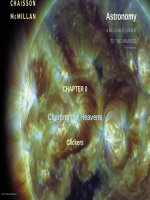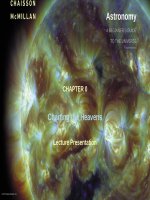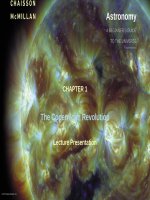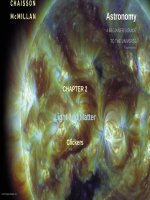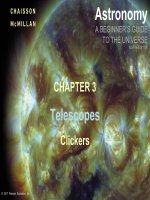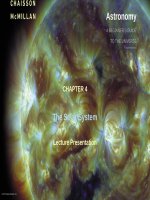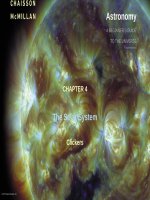Astronomy a beginners guide to the universe 8th CHaisson mcmillan chapter 09 clicker questions
Bạn đang xem bản rút gọn của tài liệu. Xem và tải ngay bản đầy đủ của tài liệu tại đây (1.1 MB, 17 trang )
Astronomy
A BEGINNER’S GUIDE
TO THE UNIVERSE
EIGHTH EDITION
CHAPTER 9
The Sun
Clickers
© 2017 Pearson Education, Inc.
Question 1
The visible light we see from our Sun comes from which part?
a)
b)
c)
d)
e)
© 2017 Pearson Education, Inc.
Core
Corona
Photosphere
Chromosphere
Convection zone
Question 1
The visible light we see from our Sun comes from which part?
a)
b)
c)
d)
e)
Core
Corona
Photosphere
Chromosphere
Convection zone
Explanation: The photosphere
is a relatively narrow layer below
the chromosphere and corona,
with an average temperature of
about 6000 K.
© 2017 Pearson Education, Inc.
Question 2
The density of the Sun is most similar to that of
a)
b)
c)
d)
e)
© 2017 Pearson Education, Inc.
a comet.
Jupiter.
Earth.
interstellar gas.
an asteroid.
Question 2
The density of the Sun is most similar to that of
a)
b)
c)
d)
e)
a comet.
Jupiter.
Earth.
interstellar gas.
an asteroid.
Explanation: The Sun is a ball
of charged gas, without a solid
surface. Jupiter has a similar
composition, but does not have
enough mass to be a star.
© 2017 Pearson Education, Inc.
Question 3
The Sun is stable as a star because
a)
gravity balances forces from
pressure.
b)
the rate of fusion equals the
rate of fission.
c)
d)
e)
© 2017 Pearson Education, Inc.
radiation and convection balance.
mass is converted into energy.
fusion doesn’t depend on temperature.
Question 3
The Sun is stable as a star because
a)
gravity balances forces from
pressure.
b)
the rate of fusion equals the
rate of fission.
c)
d)
e)
radiation and convection balance.
mass is converted into energy.
fusion doesn’t depend on temperature.
Explanation: The principle of hydrostatic equilibrium explains how stars maintain their stability.
© 2017 Pearson Education, Inc.
Question 4
The proton–proton cycle involves what kind of fusion process?
a)
b)
c)
d)
e)
© 2017 Pearson Education, Inc.
Carbon (C) into oxygen (O)
Helium (He) into carbon (C)
Hydrogen (H) into helium (He)
Neon (Ne) into silicon (Si)
Oxygen (O) into iron (Fe)
Question 4
The proton–proton cycle involves what kind of fusion process?
a)
b)
c)
d)
e)
Carbon (C) into oxygen (O)
Helium (He) into carbon (C)
Hydrogen (H) into helium (He)
Neon (Ne) into silicon (Si)
Oxygen (O) into iron (Fe)
Explanation: In the P–P cycle,
four hydrogen nuclei (protons)
fuse into one helium nucleus,
releasing gamma rays and
neutrinos.
© 2017 Pearson Education, Inc.
Question 5
A neutrino can escape from the solar core within minutes. How long does it take a photon to escape?
a)
b)
c)
d)
e)
© 2017 Pearson Education, Inc.
Minutes
Hours
Months
Hundreds of years
About a million years
Question 5
A neutrino can escape from the solar core within minutes. How long does it take a photon to escape?
a)
b)
c)
d)
e)
Minutes
Hours
Months
Hundreds of years
About a million years
Explanation: Gamma ray photons
are absorbed and reemitted continuously in the layers above the core. They gradually shift in spectrum to visible
and infrared light at the photosphere.
© 2017 Pearson Education, Inc.
Question 6
What is probably responsible for the increase in temperature of the corona far from the Sun’s surface?
a)
b)
c)
d)
e)
© 2017 Pearson Education, Inc.
The higher rate of fusion
The Sun’s magnetism
Higher radiation pressures
Absorption of X-rays
Convection currents
Question 6
What is probably responsible for the increase in temperature of the corona far from the Sun’s surface?
a)
b)
c)
d)
e)
The higher rate of fusion
The Sun’s magnetism
Higher radiation pressures
Absorption of X-rays
Convection currents
Explanation: Apparently, the Sun’s
magnetic field acts like a pump to
increase the speeds of particles in
the upper corona.
© 2017 Pearson Education, Inc.
Question 7
The number of sunspots and solar activity in general peaks
a)
b)
c)
d)
e)
© 2017 Pearson Education, Inc.
every 27 days, the apparent rotation period of the Sun’s surface.
once a year.
every 5½ years.
every 11 years.
approximately every 100 years.
Question 7
The number of sunspots and solar activity in general peaks
a)
b)
c)
d)
e)
every 27 days, the apparent rotation period of the Sun’s surface.
once a year.
every 5½ years.
every 11 years.
approximately every 100 years.
Explanation: The sunspot cycle shows a consistent 11-year pattern of activity dating back more than 300 years.
© 2017 Pearson Education, Inc.
Question 8
The solar neutrino problem refers to the fact that astronomers
a)
b)
cannot explain how the Sun is stable.
detect only one-third the number of neutrinos
expected by theory.
c)
d)
cannot detect neutrinos easily.
are unable to explain how neutrinos oscillate between
other types.
e)
© 2017 Pearson Education, Inc.
cannot create controlled fusion reactions on Earth.
Question 8
The solar neutrino problem refers to the fact that astronomers
a)
b)
c)
d)
cannot explain how the Sun is stable.
detect only one-third the number of neutrinos expected by theory.
cannot detect neutrinos easily.
are unable to explain how
neutrinos oscillate between
other types.
e)
cannot create controlled fusion
reactions on Earth.
Explanation: Further experiments have shown that solar neutrinos can change into other types that were not
initially detected.
© 2017 Pearson Education, Inc.
